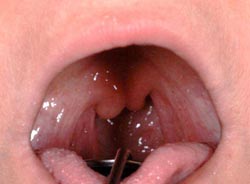Milk sugar fights deadly disease

As "uvula bifida" physician denote the longitudinal splitting of the uvula. It can be an indication of a PGM1 deficiency<br>
The disease can be easily recognized by looking into the mouth: most patients have a split uvula. The disease can be severe and affect the heart, the muscles, the liver and many other organs. Further research revealed a novel therapy: galactose can successfully be applied to treat patients. The main source of galactose is lactose, better known as milk sugar.
Scientific background
Phosphoglucomutase (PGM1) is a key enzyme in the cytoplasm of every cell. It is responsible to store energy coming from glucose in the food as glycogen if there is no need for energy, and, vice versa, to release energy from glycogen in times of exercise. In addition it has a function in the incorporation of sugars in proteins, called protein glycosylation.
A group of patients was identified with defects in this enzyme leading to a multitude of clinical symptoms. Project leader Thorsten Marquardt, University’s Children Hospital Münster: “Patients present with muscle pain or red urine after exercise, liver disease with low blood sugar levels, heart failure and other symptoms. This reflects the multitude of pathways that is linked to PGM1. But most importantly, patients can be readily identified by the presence of a split uvula which can easily be found by inspection of the mouth.” Dirk Lefeber, Radboud University Medical Center and co-leader of the project: “Innovative technology allowed us to analyze the precise glycan structures on blood proteins. This resulted in a specific biomarker that can now be applied to quickly diagnose patients with a simple blood test. The research not only linked energy metabolism with protein glycosylation via PGM1, but also highlighted important features of disease pathology.”
Personalized treatment using the sugar galactose
Protein-linked glycans from patients specifically lacked galactose. Studies in patient cells showed that addition of galactose could restore protein glycosylation without affecting glycogen metabolism. Supplementation with galactose in patients improved glycosylation. Further treatment options consist of supplementation with complex carbohydrates to stabilize blood glucose levels and avoiding aerobic exercise to prevent heart failure. In this way not only the disease mechanism was clarified, but a therapeutic concept was established and successfully applied.
Neonatal screening
In view of the therapeutic options for this life-threatening disease and the fact that some patients died of heart failure, possibilities for early screening were investigated. Deficiency of PGM1 could already be diagnosed in blood spot cards that are used in neonatal screening. This opens a promising perspective to extend current national neonatal screening programs with PGM1 deficiency for early diagnosis of patients and to initiate early intervention before onset of disease symptoms.
Notes
Radboud university medical center is an institute for patient care, research and education & training, located in Nijmegen. Our mission is to have a significant impact on healthcare. We aim to be a frontrunner in the development of innovative, sustainable and affordable healthcare. By offering excellent quality, participatory and personalised healthcare, operational excellence and sustainable networks. Our almost 10,000 employees and over 3,000 students do their utmost every day to make a positive contribution to the future of healthcare and medical sciences.
Here in the University Medicine Münster the manifold specialized competences of the University Hospital Münster (UKM) and the University Münster (WWU) meet. The UKM as a maximum care hospital with a capacity of 1,457 beds and more than 30 clinics delivers best-in-class medicine and high performance medical care to round about 56,000 ambulant patients as well as to 464,000 in-patient cases. Excellent research is conducted here by 2,000 scientists and the medical training of round about 3,000 future medical doctors is carried out at the Medical Faculty of the University Münster. Thanks to the close cooperation of both institutes the results gained from the research at the Medical Faculty are directly passed on to the health care of the University Hospital Münster.
Weitere Informationen:
http://www.nejm.org/doi/full/10.1056/NEJMoa1206605
– The New England Journal of Medicine
Media Contact
More Information:
http://www.uni-muenster.de/All latest news from the category: Health and Medicine
This subject area encompasses research and studies in the field of human medicine.
Among the wide-ranging list of topics covered here are anesthesiology, anatomy, surgery, human genetics, hygiene and environmental medicine, internal medicine, neurology, pharmacology, physiology, urology and dental medicine.
Newest articles

Properties of new materials for microchips
… can now be measured well. Reseachers of Delft University of Technology demonstrated measuring performance properties of ultrathin silicon membranes. Making ever smaller and more powerful chips requires new ultrathin…

Floating solar’s potential
… to support sustainable development by addressing climate, water, and energy goals holistically. A new study published this week in Nature Energy raises the potential for floating solar photovoltaics (FPV)…

Skyrmions move at record speeds
… a step towards the computing of the future. An international research team led by scientists from the CNRS1 has discovered that the magnetic nanobubbles2 known as skyrmions can be…





















